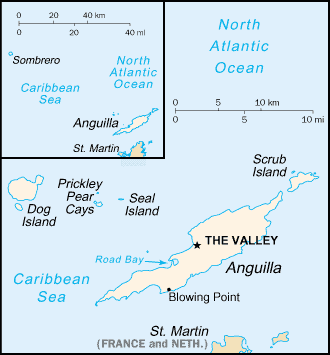
Nationality:
black (predominant) 90.1%, mixed, mulatto 4.6%, white 3.7%, other 1.5% (2001 census)

Languages:
English (official)

Religions:
Protestant 83.1% (Anglican 29%, Methodist 23.9%, other Protestant 30.2%), Roman Catholic 5.7%, other Christian 1.7%, other 5.2%, none or unspecified 4.3% (2001 census)

Population:
16,086 (July 2014 est.) country comparison to the world: 221

Age structure:
2.06% (2014 est.) country comparison to the world: 50

Birth rate:
12.68 births/1,000 population (2014 est.) country comparison to the world: 157

Death rate:
4.54 deaths/1,000 population (2014 est.) country comparison to the world: 201

Net migration rate:
12.43 migrant(s)/1,000 population (2014 est.) country comparison to the world: 11

Urbanization:
THE VALLEY (capital) 2,000 (2011)

Sex ratio:
1.75 children born/woman (2014 est.) country comparison to the world: 166

Contraceptive prevalence rate:
43% note:percent of women aged 15-45 (2003)

Drinking water source:
NA

HIV/AIDS - people living with HIV/AIDS:
NA

HIV/AIDS - deaths:
NA

Education expenditures:
2.8% of GDP (2008) country comparison to the world: 146

Literacy:
overseas territory of the UK

Government type:
NA

Capital:
none (overseas territory of the UK)

Independence:
none (overseas territory of the UK)

National holiday:
Anguilla Day, 30 May (1967)

Constitution:
several previous; latest 1 April 1982; amended 1990 (2013)

Legal system:
common law based on the English model

Suffrage:
18 years of age; universal

Executive branch:
unicameral House of Assembly (11 seats; 7 members elected by direct popular vote, 2 ex officio members, and 2 appointed; members serve five-year terms) elections:last held on 15 February 2010 (next to be held in 2015) election results:percent of vote by party - NA; seats by party - AUM 4, AUF 2, APP 1

Judicial branch:
Anguilla Progressive Party or APP [Brent DAVIS] Anguilla Strategic Alternative or ANSA [Edison BAIRD] Anguilla United Front or AUF [Osbourne FLEMING, Victor BANKS] (a coalition of the Anguilla Democratic Party or ADP and the Anguilla National Alliance or ANA) Anguilla United Movement or AUM [Hubert HUGHES]

International organization participation:
Caricom (associate), CDB, Interpol (subbureau), OECS, UPU

Diplomatic representation in the US:
none (overseas territory of the UK)

Diplomatic representation from the US:
none (overseas territory of the UK)

Flag description:
blue, with the flag of the UK in the upper hoist-side quadrant and the Anguillan coat of arms centered in the outer half of the flag; the coat of arms depicts three orange dolphins in an interlocking circular design on a white background with a turquoise-blue field below; the white in the background represents peace; the blue base symbolizes the surrounding sea, as well as faith, youth, and hope; the three dolphins stand for endurance, unity, and strength

National symbol(s):
dolphin

National anthem:
Anguilla has few natural resources, and the economy depends heavily on luxury tourism, offshore banking, lobster fishing, and remittances from emigrants. Increased activity in the tourism industry has spurred the growth of the construction sector contributing to economic growth. Anguillan officials have put substantial effort into developing the offshore financial sector, which is small but growing. In the medium term, prospects for the economy will depend largely on the tourism sector and, therefore, on revived income growth in the industrialized nations as well as on favorable weather conditions.

| | GDP (purchasing power parity):
$175.4 million (2009 est.) country comparison to the world: 221 $191.7 million (2008 est.) $108.9 million (2004 est.)

GDP (official exchange rate):
$175.4 million (2009 est.)

GDP - real growth rate:
-8.5% (2009 est.) country comparison to the world: 219

GDP - per capita (PPP):
$12,200 (2008 est.) country comparison to the world: 104

GDP - composition, by end use:
small quantities of tobacco, vegetables; cattle raising

Industries:
tourism, boat building, offshore financial services

Industrial production growth rate:
2% (2013 est.) country comparison to the world: 127

Labor force:
6,049 (2001) country comparison to the world: 220

Labor force - by occupation:
8% (2002) country comparison to the world: 89

Population below poverty line:
23% (2002)

Household income or consumption by percentage share:
39.6% of GDP (2012 est.) country comparison to the world: 45

Budget surplus (+) or deficit (-):
-5% of GDP (2012 est.) country comparison to the world: 166

Public debt:
20% of GDP (2013 est.) country comparison to the world: 135 21.7% of GDP (2012 est.)

Fiscal year:
1 April - 31 March

Inflation rate (consumer prices):
3.1% (2013 est.) country comparison to the world: 117 4.4% (2012 est.)

Central bank discount rate:
6.5% (31 December 2010 est.) country comparison to the world: 55 6.5% (31 December 2009 est.)

Commercial bank prime lending rate:
9.4% (31 December 2013 est.) country comparison to the world: 93 9.38% (31 December 2012 est.)

Stock of narrow money:
$16.89 million (31 December 2013 est.) country comparison to the world: 189 NA% (31 December 2012 est.)

Stock of broad money:
$384.4 million (31 December 2013 est.) country comparison to the world: 183 $373.2 million (31 December 2012 est.)

Stock of domestic credit:
$498.1 million (31 December 2013 est.) country comparison to the world: 167 $483.3 million (31 December 2012 est.)

Current account balance:
-$54.3 million (2013 est.) country comparison to the world: 70 -$44.8 million (2012 est.)

Exports:
$12.2 million (2013 est.) country comparison to the world: 211 $7.3 million (2012 est.)

Exports - commodities:
lobster, fish, livestock, salt, concrete blocks, rum

Imports:
$140.1 million (2013 est.) country comparison to the world: 207 $129.3 million (2012 est.)

Imports - commodities:
fuels, foodstuffs, manufactures, chemicals, trucks, textiles

Debt - external:
$8.8 million (1998) country comparison to the world: 198

Exchange rates:
East Caribbean dollars (XCD) per US dollar - 2.7 (2013 est.) 2.7 (2012 est.) 2.7 (2010 est.), 2.7 (2009) |

















